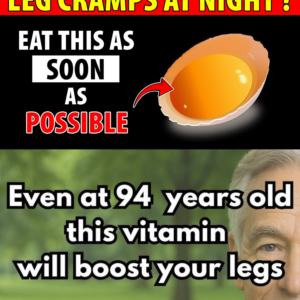Top 3 Foods to Prevent Leg Cramps in Seniors: Strengthen Your Legs and Boost Mobility Naturally
As we age, our bodies naturally go through a series of changes—some expected, others less welcome. One of the most common and frustrating issues seniors experience is leg cramps, particularly at night or after a period of inactivity. These sudden, involuntary contractions of leg muscles can cause intense pain and disturb sleep, mobility, and overall quality of life.
While leg cramps can be caused by a number of factors—including dehydration, lack of stretching, or medication side effects—diet plays a powerful role in preventing and managing them. By focusing on certain nutrients like potassium, magnesium, calcium, and hydration-supporting compounds, seniors can take meaningful steps toward reducing the frequency and severity of cramps.
In this article, we explore the top three foods proven to help prevent leg cramps in seniors, supported by scientific reasoning and easy-to-follow dietary tips. If you’re looking to strengthen your legs, improve circulation, and say goodbye to those painful nighttime spasms, keep reading!
Why Do Seniors Experience More Leg Cramps?
Before diving into the top foods, it’s important to understand the underlying causes of leg cramps in older adults. Some of the most common triggers include:
Electrolyte imbalances, especially low potassium, magnesium, or calcium
Dehydration
Poor circulation or narrowing of blood vessels
Nerve compression in the lower spine
Medication side effects, including diuretics or statins
Lack of physical activity or overstretched, fatigued muscles
With these causes in mind, a nutrient-rich diet focused on hydration and muscle-supporting minerals can make a big difference.
 1. Bananas – Nature’s Perfect Electrolyte Booster
1. Bananas – Nature’s Perfect Electrolyte Booster
Why Bananas Work:
Bananas are one of the best-known sources of potassium, a vital mineral that helps regulate muscle contractions, maintain nerve function, and keep fluids balanced. Low potassium levels are one of the leading causes of leg cramps in older adults.
In addition to potassium, bananas also provide magnesium and vitamin B6, both of which further support nerve and muscle function.
Nutritional Snapshot (1 medium banana):
Potassium: ~422 mg
Magnesium: ~32 mg
Vitamin B6: ~0.4 mg
Fiber: ~3 g
How to Incorporate Bananas:
Add sliced banana to morning oatmeal or yogurt
Blend into a smoothie with Greek yogurt and spinach
Eat one as an easy on-the-go snack
Pro Tip: Pair bananas with a small handful of almonds (also rich in magnesium) for a powerful anti-cramp combo.
Bonus: Bananas are soft, easy to chew, and gentle on the digestive system—perfect for seniors who may have dental issues or sensitive stomachs.
 2. Leafy Greens – The Calcium and Magnesium Powerhouse
2. Leafy Greens – The Calcium and Magnesium Powerhouse
Why Leafy Greens Work:
You probably know that calcium is essential for strong bones—but did you know it also plays a major role in muscle contraction and relaxation? A lack of calcium can cause nerves to fire improperly, leading to painful cramps.
Leafy greens like spinach, kale, Swiss chard, and collard greens are packed with calcium, magnesium, potassium, and vitamin K, all of which are critical for nerve function, muscle repair, and blood clotting.
Nutritional Snapshot (1 cup cooked spinach):
Calcium: ~245 mg
Magnesium: ~157 mg
Potassium: ~839 mg
Vitamin K: > 1000% RDA
How to Incorporate Leafy Greens:
Sauté spinach or kale with garlic and olive oil for a nutrient-rich side
Add chopped greens into soups, stews, and casseroles
Blend into smoothies (you won’t taste them, promise!)
Include a side salad with every meal
Pro Tip: Cook leafy greens lightly to reduce oxalates, which may interfere with calcium absorption. Steaming or sautéing is ideal.
Bonus: Greens are also excellent for heart health and blood pressure regulation, addressing other age-related concerns.
 3. Coconut Water – The Ultimate Hydration Helper
3. Coconut Water – The Ultimate Hydration Helper
Why Coconut Water Works:
Leg cramps are often the result of dehydration, particularly among seniors who may not drink enough water due to a reduced sense of thirst. Coconut water is nature’s sports drink—low in calories, high in electrolytes, and exceptionally hydrating.
It contains potassium, magnesium, sodium, and calcium, helping replenish electrolyte stores lost through sweat or medication-induced urination (especially diuretics). Compared to regular water, coconut water offers a faster, more effective way to rehydrate.
Nutritional Snapshot (1 cup coconut water):
Potassium: ~600 mg
Magnesium: ~60 mg
Sodium: ~250 mg
Calcium: ~58 mg
How to Incorporate Coconut Water:
Drink a glass in the morning to kickstart hydration
Use as a base for fruit smoothies
Freeze into ice cubes and add to regular water for flavor and benefits
Sip during and after light exercise or walking
Pro Tip: Choose unsweetened coconut water to avoid added sugars. Read the label carefully—some brands sneak in artificial flavors or sweeteners.
Bonus: Coconut water is easy on the stomach, making it a great option for seniors with digestion or medication-related nausea.
 Other Helpful Foods to Include
Other Helpful Foods to Include
While bananas, leafy greens, and coconut water top the list, several other nutrient-rich foods also deserve honorable mention:
 Avocados
Avocados
Packed with potassium, magnesium, and healthy fats, avocados support nerve health and muscle performance.
 Salmon & Sardines
Salmon & Sardines
Rich in omega-3s and vitamin D, these fatty fish reduce inflammation, support bone density, and enhance muscle recovery.
 Dairy or Fortified Plant Milk
Dairy or Fortified Plant Milk
Excellent sources of calcium and vitamin D, both crucial for preventing cramping and maintaining bone and muscle strength.
 Sweet Potatoes
Sweet Potatoes
Full of potassium, magnesium, and complex carbs to replenish muscle glycogen after physical activity.
 Foods and Habits That May Worsen Cramps
Foods and Habits That May Worsen Cramps
Along with adding anti-cramp foods, it’s important for seniors to limit or avoid certain items that may trigger cramps:
Excess caffeine (dehydrates and can deplete minerals)
Alcohol (also causes dehydration)
Highly processed foods high in sodium and preservatives
Low-carb diets that eliminate potassium-rich fruits and veggies
Skipping meals, leading to unstable blood sugar and electrolyte loss
Note: Always consult a doctor or registered dietitian before making major dietary changes, especially if managing conditions like diabetes, kidney disease, or high blood pressure.
 Bonus Tips to Prevent Leg Cramps Naturally
Bonus Tips to Prevent Leg Cramps Naturally
Diet is key, but combine your food choices with these strategies for optimal results:
Stretch daily, especially calves and hamstrings
Stay hydrated throughout the day
Elevate legs after long periods of sitting
Use warm compresses before bed to relax muscles
Take an evening walk to improve circulation
Ensure adequate vitamin D through sun exposure or supplements
 A Sample Day of Anti-Cramp Meals for Seniors
A Sample Day of Anti-Cramp Meals for Seniors
Breakfast
Oatmeal with sliced banana and chia seeds
Glass of unsweetened coconut water
Mid-Morning Snack
Handful of almonds
Herbal tea
Lunch
Grilled salmon over sautéed spinach and quinoa
Mixed greens salad with olive oil dressing
Afternoon Snack
Smoothie with avocado, coconut water, kale, and pineapple
Dinner
Baked sweet potato
Steamed broccoli and grilled chicken or tofu
Fortified almond milk or low-fat yogurt
Evening Routine
Light stretching
Warm bath or foot soak with Epsom salt (magnesium)
Herbal tea or warm milk before bed
 The Mind-Body Connection
The Mind-Body Connection
Cramping isn’t just a physical issue—it can have emotional impacts too. Constant pain or interrupted sleep can lead to:
Anxiety around bedtime
Reduced motivation for physical activity
Feelings of helplessness
That’s why a holistic approach matters. Eating well, staying active, and taking care of mental well-being are essential for managing chronic discomforts like leg cramps.
 Final Thoughts: Food Is Powerful Medicine
Final Thoughts: Food Is Powerful Medicine
For seniors, leg cramps don’t have to be a painful, unavoidable part of aging. Through strategic, nutrient-focused food choices like bananas, leafy greens, and coconut water, it’s possible to significantly reduce cramping, enhance mobility, and enjoy better overall health.
These three foods aren’t just delicious—they’re tools of empowerment. With consistency and support from caregivers or family, seniors can reclaim comfort, enjoy restful nights, and walk with strength and confidence.
So the next time a leg cramp strikes, remember: the solution might just be in your kitchen.
News
Vivansh World Record: 4-Month-Old Baby Makes History, Everyone Shocked! Breaking News
Vivansh World Record: 4-Month-Old Baby Makes History, Everyone Shocked! In a world where records are set by seasoned athletes, technological prodigies, and lifelong achievers, a tiny miracle has stunned the globe. At just four months old, baby Vivansh Rajendra…
Ram Kapoor’s Wife Gautami Lashed Out Ekta Kapoor For Dig At Her Husband’s Weight Loss
Gautami Kapoor Shuts Down Ekta Kapoor’s Remarks on Ram Kapoor’s Weight Loss: A Bold Statement on Health, Respect, and Love In the glitzy world of Indian television, where image often overshadows essence, one power couple just reminded the world…
Terrible News: Popular TV Actor Aasif Sheikh Involved in an Accident
Terrible News: Popular TV Actor Aasif Sheikh Involved in an Accident In a recent and alarming incident, renowned television actor Aasif Sheikh, best known for his role as Vibhuti Narayan Mishra in the popular sitcom Bhabiji Ghar Par Hain,…
Mohammad Faiz and Neha Kakkar – Superstar Singer Season 2
Mohammad Faiz and Neha Kakkar – A Magical Journey on Superstar Singer Season 2 In the realm of reality television, few shows manage to capture hearts across generations the way Superstar Singer has. With a focus on young singing…
Top 6 Nutrients to Stop Leg Weakness in Seniors – Fast!
Top 6 Nutrients to Stop Leg Weakness in Seniors – Fast! As we age, maintaining strength and mobility becomes increasingly essential to living independently and enjoying a high quality of life. One common complaint among seniors is leg weakness,…
Top 10 Foods to Prevent Leg Cramps in Seniors — Even at Night!
Top 10 Foods to Prevent Leg Cramps in Seniors — Even at Night! Leg cramps are painful, involuntary muscle contractions that can strike without warning—often at night, disrupting sleep and affecting quality of life. Seniors are especially vulnerable…
End of content
No more pages to load











